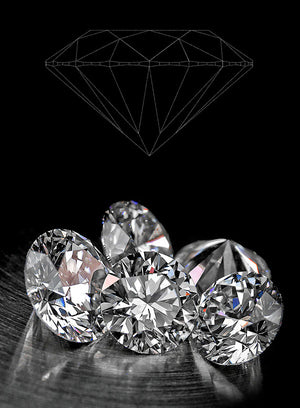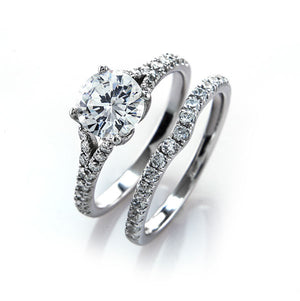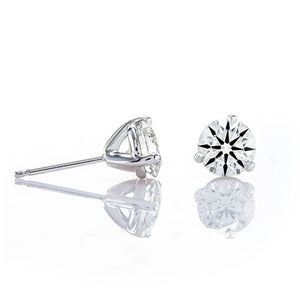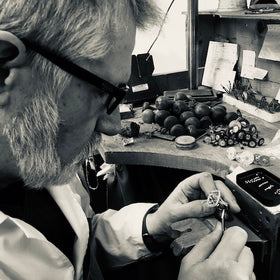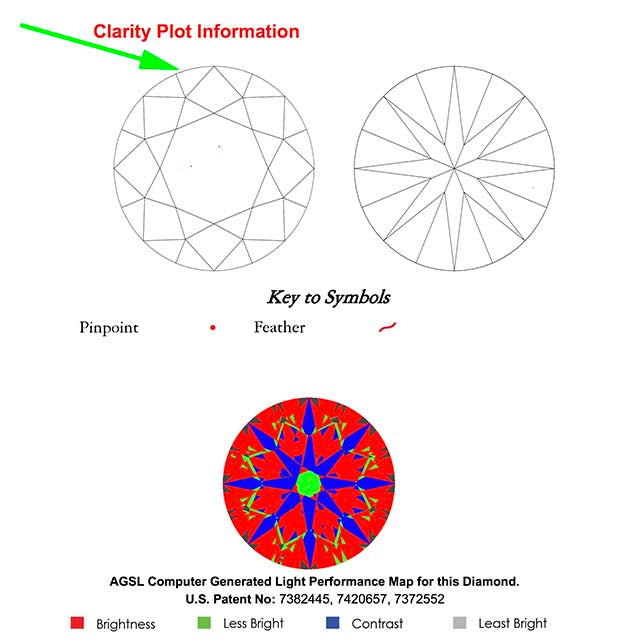
Which diamond inclusions should I avoid?
“I’m looking for something like this 1.535 carat, F-color, VVS-2 clarity, Black by Brian Gavin diamond. High color and clarity are a must, but we also don’t want to sacrifice cut quality. This diamond looks perfect, except my fiancé is concerned about the feather. However, I can’t even find the feather indicated on the plotting diagram. I’m up against the wall here, because I don’t think I can afford a VVS-1 or Internally Flawless diamond and we have to draw the line somewhere. Can you tell me whether we should be concerned about a feather in a VVS-2 clarity diamond? Does it present any sort of durability risk? At the same time, can you tell me which diamond inclusions I should avoid?”
VVS-2 clarity diamond with feather – is it bad?
Let’s start out with what is a feather within a diamond and determine whether it is good, bad, or of no consequence. By definition, a feather is a fracture within the crystal structure of a diamond. I suppose that this type of inclusion is referred to as a feather instead of a fracture, because that sounds more romantic. Nothing says panic like there is a fracture in your diamond, right?

At the same time, everything is a matter of perspective, and the fact is that these tiny fractures look a lot like feathers when viewed under higher degrees of magnification. That is of course, assuming you can find them, which can be a challenge when they are quite small. For example, the feather in this 1.535 carat, F-color, VVS-2 clarity, Black by Brian Gavin diamond is minute, extremely small, and is literally of no consequence (good luck finding it, right?). As you’ve indicated, you can’t find the symbol that indicates a feather on the plotting diagram, but if you enlarge the size of the report high enough, you’ll see a red speck right there.
Where? Right along the girdle edge where the green arrow is pointing at the upper girdle facet. Now, do you really think this is the type of feather you need to be concerned about?
Probably not, right? After all, it’s super small, more accurately described as “minute” and what we describe as being of no consequence because it is unlikely to present any sort of durability risk.
How do you know? Because when you look at the clarity photograph, you can’t even find the feather because it’s so small. This is not the sort of feather in a diamond that is likely to be an issue, what you want to avoid are feathers which are large, but even that is mostly just for peace of mind because it’s extremely rare for a feather to spread or be an issue.
Are Feathers in a Diamond Bad?
 Deciding whether feather inclusions within a diamond are bad, is something which diamond dealers have feverishly debated ever since the dawn of time (what do you think A.D. stands for?). Let’s face it, when you look at a magnified photograph of the extensive feathers visible within this SI-2 clarity diamond, they are likely to give you pause. As well they should I suppose, since we’re talking about fractures within a diamond crystal. The concept is rather haunting, is it not?
Deciding whether feather inclusions within a diamond are bad, is something which diamond dealers have feverishly debated ever since the dawn of time (what do you think A.D. stands for?). Let’s face it, when you look at a magnified photograph of the extensive feathers visible within this SI-2 clarity diamond, they are likely to give you pause. As well they should I suppose, since we’re talking about fractures within a diamond crystal. The concept is rather haunting, is it not?
At the same time, the diamond crystal did survive the immense pressure placed on it during the cutting process…
Imagine the immense amount of pressure and heat created while polishing a diamond (the hardest mineral substance on earth) and yet, the diamond did not crack under pressure. Which is a pretty good indicator that it will survive the pressures of everyday life on your finger, don’t you think?
At the same time, there is always the possibility that you could strike your ring against something harder with enough force to inflict damage, such as a chip, or a crack, but what are the odds that you’d strike the ring in just the right spot for a feather to expand? The odds seem pretty slim, it’s probably more likely that you’d damage the diamond in a new spot, but then again, that’s why you buy jewelry insurance, right?
Suffice to say that deciding whether feathers in a diamond are good or bad is largely a matter of perception and personal preference. The reality is that most feathers don’t pose any sort of substantial durability risk once the diamond has been cut, but they do present some people with a bit of a mental hurdle just because of what they are, a small fracture within the crystal structure.
Less Desirable Inclusions Within Diamonds:
There are other types of inclusions within diamonds that present more of an issue than most feathers. Those would be cavities, chips, etch channels, knots, and laser drill holes. Here again, such inclusion types are not necessarily bad simply by definition but might be something you prefer to avoid depending on the location and extent of the inclusion.
At the same time, there are people who prefer to take more of a broad-strokes type of approach and avoid certain types of inclusions altogether. It’s all a matter of weighing the options and deciding how to massage the characteristics of a diamond to get the look you want at a price you can afford.
 By definition, a cavity is exactly what it sounds like, it can be an empty hole inside of the diamond, or a hole in the surface of a diamond, and one of those things is not like the other… I can’t see how a small hole buried well within the body of a diamond could present any sort of issue at all.
By definition, a cavity is exactly what it sounds like, it can be an empty hole inside of the diamond, or a hole in the surface of a diamond, and one of those things is not like the other… I can’t see how a small hole buried well within the body of a diamond could present any sort of issue at all.
While a small cavity on the surface of a diamond might be apt to fill-up with dirt and grime and be difficult to clean if it’s in the wrong place but might present no issue at all if it’s extremely small and located in an area that is easy to clean. The cavity within this diamond is indicated by the red arrow.
A chip is something that most people find more disconcerting than a cavity, because it is a chip in the surface of the diamond. People tend to be less concerned with knots, which by definition are an included diamond crystal that breaks the surface of a diamond.
Etch channels are a little more confusing because they can either be caused by little gas bubbles escaping the body of the diamond while it is being formed or might be the result of laser drilling a diamond to reduce the significance of an inclusion.
From a gemological perspective, the different types of inclusions simply represent the characteristics of the diamond which we base the clarity grade on. By definition, the inclusions are neither good nor bad, but rather become so depending on the personal preferences and perception of each person.
An inclusion that bothers one person might not concern another person in the slightest. A minute feather in a VVS-2 clarity diamond is certainly of no concern to me, it’s literally of no consequence as near as I can tell. There are certainly more prominent inclusion types to be concerned about in diamonds of lower clarity grades where they are larger and more obvious. Once you crossover into the VS-2 and higher clarity grades, the extent of most inclusions are well, very slight (pun intended).





